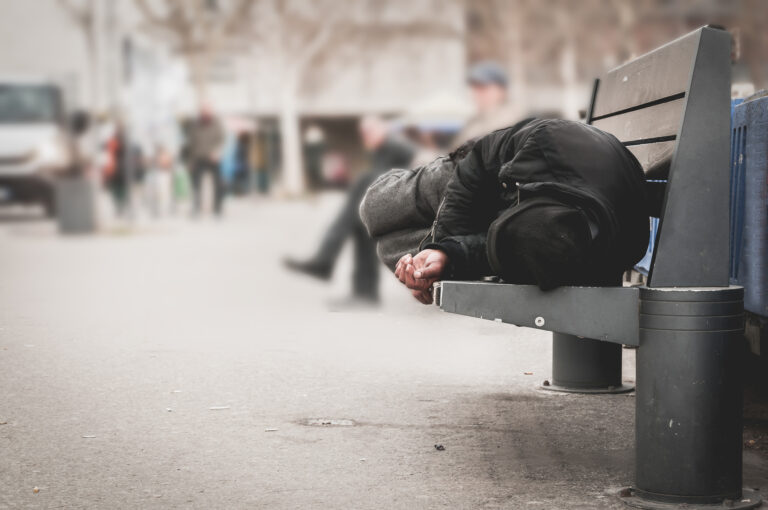Everyday Architecture Or a weapon Of Mass Exclusion?

Maybe it’s a metal “arm rest” inserted smack dab into the middle of a bench at the park.
Maybe it’s the random spikes protruding from flat surfaces where people often gather.
Maybe it’s the awkwardly slanted window sills or thousands of stones thrown under a bridge.
Maybe it’s nothing at all.
What Is Exclusionary Architecture?
For centuries, everyday architecture within our communities has acted as a key weapon of mass exclusion – pushing those experiencing homelessness out of public spaces and making what little these individuals have access to, virtually inaccessible.
Exclusionary architecture, also known as hostile architecture, is an anti-homeless urban policy strategy that essentially functions exactly as it sounds: to exclude the homeless from public spaces often through the use of strategically designed physical structures.
Sometimes these structures are disguised as art and other times they shamelessly display random spikes, slants, stones, and curvature that prevent the homeless from gathering, resting, or just being in that area.
What Are Examples of Exclusionary Architecture?
In 2019 in Portland, Oregon, for example, the Oregon Department of Transportation covered five homeless encampment sites with a layer of boulders preventing the homeless from living there and costing the city well over $800,000 – money that could’ve, and should’ve, been invested into actual housing solutions.
Other cities have taken a different approach to keep those experiencing homelessness out of public spaces and instead of adding – boulders, spikes, “arm-rests” or whatever it may be – they’ve removed physical structures that are often used by the homeless as their only place to reside.
San Francisco did this back in the 1990s when they removed all benches near the central plaza and the New York City Subway did the same just last year when they removed all benches from stations “to prevent the homeless from sleeping on them.”
In other areas across the county, cities have opted to go as far as removing sidewalks or even adding medians to prevent people from making left turns.
Why Exclusionary Architecture Is Harmful To Those Experiencing Homelessness
While city officials are often quick to defend these practices as a “safety measure,” or an “intervention” to maintain the city’s desirability, in reality, it’s quite the opposite.
What’s really happening here is public officials are prioritizing aesthetics, image, and perceived status over the actual lives of the human beings they are supposed to serve, protect, and act in the best interest of.
By doing so, individuals and families experiencing homelessness are being cut off from what is often the only space they have available to them, forcing them into even more unsafe and unsanitary living conditions.
So much for acting as a safety precaution right?
Dima Stouhi explains that the implementation of exclusionary architecture is harmful because “for the homeless, public spaces are a refuge.” Those experiencing homelessness “rest on benches, under bridges, [and] on the sidewalks…as they do not have the means to linger in a private space. These public spaces, regardless of their form, scale, or location, become their temporary homes in which they settle throughout the night.”
So when those experiencing homelessness are cut off from these spaces, they’re left with virtually nowhere to go.
Community Advocates Are Making a Difference and YOU Can Too!
As everyday architecture and urban policy continue to fail those who are struggling most in our communities, advocates across the country are taking to social media, starting petitions, and fighting against these hostile initiatives.
In fact, within a day of removing the benches from the New York City Subway, public outcry on social media calling this action out as “cruel” and “evil” led to the Metropolitan Transportation Authority deleting their initial tweet (that they were removing benches “to prevent the homeless from sleeping on them”), later saying that it was “posted in error,” and within a week putting the majority of public benches were put back in the city’s subway stations.
Other local advocates in Seattle evoked similar change in 2018 when they successfully petitioned to get bike racks removed which were originally placed in the community in an effort to discourage people experiencing homelessness from camping there.
While much more needs to be done at a systemic level to combat the current homelessness crisis in America, collectively, people across the country are making a difference and doing their part in building a better future for all.
Be Part of the Change
At J&J Lovelace Foundation, we are on a mission to bridge the gap between surviving and thriving for those experiencing homeless and other hardships by raising money to provide tangible resources, tools, and support for a better future.
Join us on our mission by making a donation to the J&J Lovelace Foundation today. Your generosity will be used to create affordable housing solutions, provide life-saving substance use and mental health treatment, help people gain employment through training programs, and improve the living conditions for those who are unhoused.
You have the power today to change tomorrow. Donate now or learn other ways you can get involved!
-Written by Cassie Cipolla for J&J Lovelace Foundation

